|
EXPERIMENTS
Experiments are patterns we follow when we are trying to
find the causes and reasons of different events.
The answers we find tell us 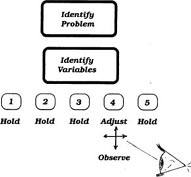 what
to increase to get better results. what
to increase to get better results.
The answers also tell us what to decrease to be more
efficient and effective.
A good pattern to follow in experimenting is:
- Identify the problem.
- Identify the variables. (We learned how to do this in
the last chapter)
- Hold all variables constant.
- Adjust one variable.
- Observe the results.
- Draw a conclusion from the results.
- If necessary, repeat the experiment, adjusting other
variables to see which is the most influential.

|
|
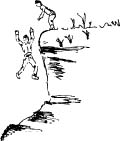
|
My second year of teaching, I was in a very small
village. When I arrived there, the students tried to win my
favor. One of the boys, a first grader, said to me, "Me and
Joe put feathers in our pockets and jumped off the bank, but
we didn't fly." I struggled to keep from letting my smile
show. Some time later, I thought about that experience, and
felt very embarrassed. The two boys had done a great science
experiment, and I had inwardly laughed at them.
- They knew that flying was possible. They saw birds do
it.
- They knew that birds have feathers and we don't.
They finished their experiment still puzzled. They found
out what did not cause flying. Feathers alone will not make
you fly. They were certain of that.
What was good about their experiment?
- They were curious.
- They had an idea they wanted to test.
- They had the boldness to test their idea.
Why didn't they come to a clear understanding?
They discovered that feathers in pockets do not cause
flying. They didn't discover what does cause flying.
They needed to take it further.
|


|
Example: Consider this simple experiment:
1) Mary wanted to find out if her family preferred
chocolate chip or oatmeal cookies.
2) She identified all the variables.
- size of cookies
- number of cookies
- location of cookies on table or shelf
- containers
- access to all family members
- type of cookie
3) She held all of the variables but one constant.
Cookies were
- the same size
- the same quantity
- the same time
- in the same place on the counter, and
- in identical containers.
- available to the whole family.
4) She adjusted one variable, the type of
cookie: chocolate chip and oatmeal.
5) It didn't take long to discover by counting that
chocolate chip was preferred over oatmeal, three to one.
The next Christmas, everyone received a box of cookies
from Mary containing twelve chocolate chip cookies and four
oatmeal cookies.
What mistakes could she have made in the experiment?
However, she did it right. She held all the variables
constant but one.
This was a good experiment! Mary could take this to a
science fair.
Again, in a good experiment we:
- Identify the problem.
- Identify all the variables.
- Hold all the variables still (constant),
- Adjust one variable and observe.
- Draw a conclusion from the results.
- Repeat the experiment adjusting other
variables if necessary to clarify the
conclusion.
|
|

|
EXPERIMENTS YOU CAN PERFORM
Wes is a good cross country skier. He isn't sure what
kind of wax will perform the best under a given snow
condition. Could he wax one ski one way and the other ski
the other, and test it this way? What are the variables he
would be holding constant by doing it this way? Can you
think of a better way to find the best wax?
Wes later wanted to see if waxless skis were better for
going up hills. How could he test this?
|
|
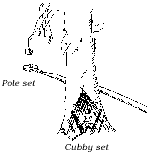
|
Hank is a dedicated trapper. He knew that in
some parts of the country marten prefer pole sets.
In other parts of the country, they prefer cubby
sets. He decided to have several test sites. He put
a cubby set and a pole set side by side. Is this a
good experiment if he uses the same bait and keeps
good records?
How could Hank test different kinds of
baits?
Nan's mom told her that damp socks cause much
greater heat loss than dry ones.
|
|
|



|
She:
- got two identical thermometers.
- dampened the liner of her left shoe pack, and put it
back into the shoe pack.
- put one thermometer in the dry right shoe pack and
one in the wet left one.
- covered each pack with identical pieces of thick
cloth so they would not lose heat out of the top.
- brought both shoe packs outside when it was
-30°.
- Twenty minutes later, she went to check the
temperature inside each shoe pack.
What do you think she discovered? What would have
happened if she went at different time intervals?
With that experiment done, she again dampened the liner
of her left shoe pack and dried the liner of the right one.
She put them on and went outside to play. What do you think
she discovered?
After this, Nan wanted to test whether cotton or wool is
a warmer material for winter weather. How could she
duplicate the above experiment to test the materials?
Antone couldn't afford the expensive bunny boots that
other people were wearing. He knew that his own sweat was
condensing in the liner, freezing it to the outside of the
shoe pack. He knew that Bunny boots have a vapor barrier
that keep the moisture of the person's feet from the felt
liner sealed in the boot. He tried an experiment. He put one
shoepack on as he normally did. He put a sock on his other
foot and wrapped that foot with a plastic shopping bag. He
went outside. What do you think he discovered?
John often heard from the old timers that eating snow
when you are out walking will make you very tired. They
always warned him not to do it. Could John safely test this?
Is there a science fact that would help him understand the
truth in the old timers' statement?
|

|
How important is the temperature of cooking oil? Make
donuts of the same batter in the same shape and size. Cook
them separately in oil of different temperatures. Leave them
in the hot oil for exactly the same amount of time. What is
your conclusion?
Do the above experiment keeping the oil the same
temperature. Hold all variables constant except that some
donuts will have holes and others do not.
What is your conclusion? Why do donuts have holes? What
can you say about angel food cakes? How does that relate to
the head of a chainsaw?
|

|
Fred cut his hand. One day he put alcohol on it. The next
day he tried a leading ointment. He said it seemed to heal
better with the ointment. Was this a good experiment? How
might a good experiment be done?
For all of the following, determine all the variables.
Identify which ones are being adjusted.
Test different kinds of paper as freezer wrap for meat.
Wrap identical pieces of meat with different types of wrap.
Check after one month. Which one protects the meat from
"freezer burn" (drying)? Try different methods of
wrapping.
Once you have found the best wrapping paper, do the
experiment over the winter, checking a different package of
meat each month.
Cut fish three or four different styles. Hang the fish
side by side. Which style produces the best tasting fish for
eating during the winter?
|
|
Radios have built in limited reception so people in
cities will not have too many stations covering over each
other. In the north, this isn't a problem. Our problem is
picking up remote stations.
Make a coil 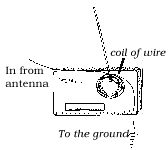 of
insulated wire as illustrated here, to greatly increase the
number of stations received. To do this, hook one end of the
wire to a good ground and the other end to the antenna. Do
not connect, just place the coil behind the radio.
Move it around until you get the best reception. This
greatly magnifies the signal. of
insulated wire as illustrated here, to greatly increase the
number of stations received. To do this, hook one end of the
wire to a good ground and the other end to the antenna. Do
not connect, just place the coil behind the radio.
Move it around until you get the best reception. This
greatly magnifies the signal.
Experiment with the:
- size of coil three inches to eight inches and
- the number of turns of wire in the coil five to
thirty turns.
What is the best combination of coil size and number of
wraps in your location?
|
|

|
Cut meat into different size pieces, equal amounts of
each different size. Cook (either boil or fry) for the same
amount of time. What can you say about the relationship of
cooking time and the size of the pieces.
|
|

|
|
16 oz.
|
8 oz.
|
|
Sell juice at a basketball game. Use two different size
cups, but let the price per ounce be the same. Example:
Use the same juice.
Which do people prefer?
Once you have determined this, see if there is some way
that you could have attractive cups and unattractive cups of
the same size, selling for the same price. Does packaging
change people's choices?
Let everyone in the class take a picture of the same
object. The variables held constant are: Camera, film,
object. The variables the students control are:
- angle
- distance
- background contrast
- other props included to enhance the photo.
|
|

|
Set rabbit snares experimenting with:
- size of opening
- height of snare from trail
- with or without a fence
|
|
|
Cut a block of wood with a dull chainsaw. Time the cut.
Sharpen the saw and cut the same block, timing  the
cut again. How much difference is there? Are there variables
here that you must be careful to control? the
cut again. How much difference is there? Are there variables
here that you must be careful to control?
Cut identical blocks with two saws that are both dull,
but one is a bigger saw and the other a smaller one. Time
the cuts.
Sharpen both saws. Cut the same blocks again. Which saw
is affected most by a dull chain?
|
|

|
One team plays basketball in socks against a team that
has tennis shoes. At halftime, switch roles, socks and
shoes. Does traction (friction) make much difference in the
score? How much?
|
|
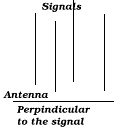
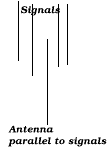
|
Experiment with TV or radio antennas. Is reception
better:
- with the antenna parallel or perpendicular to the
transmitting station?
- during the day or night?
Problem: How will you measure the strength of the
signal?
Can  you
shoot a rifle better standing, kneeling, lying down, or
resting the rifle against a tree? Experiment with
supervision. you
shoot a rifle better standing, kneeling, lying down, or
resting the rifle against a tree? Experiment with
supervision.
What d o
old timers tell you about breathing when shooting? o
old timers tell you about breathing when shooting?
What is different about shooting from a boat in
waves?
Wash one side of your head with one kind of shampoo, and
the other side with another. (Or, don't use any soap on the
other side at all). Can you tell the difference? Can others
notice the difference?
If TV commercials have integrity, they are excellent
experiments, as all variables are held constant except the
product.
Test hair conditioner in the same way.
|
|

|
Use one kind of acne medicine on one side of your face
and a different brand on the other side. Which works better?
What variables are being held constant? Read the contents of
the "different" medications. Are the contents different, the
concentrations, or just the name on the box?
|
|

|
Are mittens or gloves warmer? How could you test this
without thermometers?
|
|

|
Put a trail snowshoe on one foot and a smaller bear paw
on the other. Walk on a hard-packed trail.
Go out in the woods or tundra and break trail. What do
you observe? Try both types of snowshoes in powder snow.
|
|

|
Try one kind of popcorn in both the microwave and in a
pot. Try microwave popcorn in the microwave and in a pot.
What is the difference in results? Why do you think they are
different? Which is more efficient?
 
Make two campfires with identical setups except one fire
is made with dry wood, and the other with green wood. What
conclusions do you come to?
|
|

|
Once the above drywood fire is burning, add two blocks of
the same size, one dry and the other green. Which burns
hotter? Which burns longer?
Does wood split easier in warm or cold weather? Cut
blocks of equal lengths from a tree that looks difficult to
split. In order to get two approximately equal piles of
blocks, put the first block in the first pile. the second
one in the second pile, third one in the first pile and
continue to alternate until the whole tree is in two piles
of about equal size.
Split one pile in warm weather. Record the time. Split
the second pile in very cold weather. Record how long it
takes. There are variables you will not be able to control,
so this will be a crude experiment. The same person should
use the same axe or maul.
|

|
In the summer, put equal amounts of different brands of
bug dope on opposite hands. Is there a difference?
Afterwards, look at the ingredients and concentrations of
both on the containers. Does this help you understand your
results?
|

|
On a very cold day, scuff your feet on a rug (nylon socks
work best). Hold a key in your hand. Slowly approach a
doorknob. At what distance will it spark from the key to the
doorknob? Have two people hold hands and repeat the above
experiment with the same key, same rug, same day and same
doorknob. Record the length of the spark. Will the length of
the spark increase if there are three, four, or five people
in a row holding hands and scuffing feet?
Try the same experiment on a warm day. Be sure to have
the same shoes or socks on. Record the spark length. Compare
with the results of a cold day.
Ask someone who knows about computers what is done to
keep "electric students" from zapping computers on cold dry
days. Static electricity is a real danger for computers.
|

|
|
Old
Faithful
|
New
lure
|
|
Test a new fishing lure. Be careful to keep the variables
of location, depth, rate and method of retrieve etc.
constant.
The first grade teacher was frustrated. She bought new
crayons, but soon they were broken into small pieces. She
devised an experiment to show the students what was
happening. She bought a small box of crayons, and insisted
that the students leave the paper on them. She bought
another box of crayons, and peeled all the paper off them.
What do you think they discovered? Try it.
Return to the section on Variables, Chapter 6.
- Choose several of the situations there.
- Describe how you would do an experiment in those
situations.
Create: Think of situations of your own
- questions you have wondered about
- things you have wanted to prove to someone
Describe how you would experiment in those
situations.
|
|
|
Looking ahead: The following experiments you will
not be able to perform now, but might be faced with later.
They are actual experiments that go on every day.
A TV company wants to see if a certain program would be
viewed by more people if presented at a different time. How
could they perform an experiment to test this?
A nationwide company wants to see if a new health
insurance program will cut down on expenses.
A Native corporation wants to see if a summer program
will help Native students succeed in college.
What other variables do you think influence success in
college?
A school district  thinks
a certain math program will help its students. How can they
determine the effectiveness of the program? thinks
a certain math program will help its students. How can they
determine the effectiveness of the program?
Many years ago, a student did a simple experiment, "Why
Your Tongue Sticks To the Flagpole". He used a piece of
towel instead of a human tongue. He tried to stick the towel
to:
- glass
- wood
- plastic
- steel
- painted steel
He tried the above materials
- when the materials were warm and cold
- when the towel was either wet or dry
|
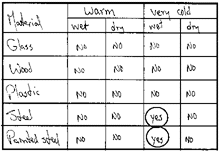
|

|
None of the materials stuck to the dry towel. Cold steel,
painted or unpainted stuck to the wet towel.
From this, he drew a scientific conclusion, and placed
very well in physics in the State science fair.
Can you think through and determine why a wet cloth
(imitation tongue) sticks to cold metal, and none of the
other materials?
It doesn't take a fantastic experiment to succeed in a
science fair. It takes good science technique!
The real science adventure comes in doing something no
one else has done. You will be amazed at what will attract
attention of judges and people at a science fair. You will
be amazed at what you can discover!
|

CONCLUSION OF THIS
BOOK
I have tried to teach a way of creative scientific
thinking using Alaskan experiences. One, two, ten and even
twenty years from now, you will surprise yourself and others
with the ingenious and sensible solutions you develop for
problems. Why? Because true Alaskans are never stuck.
|